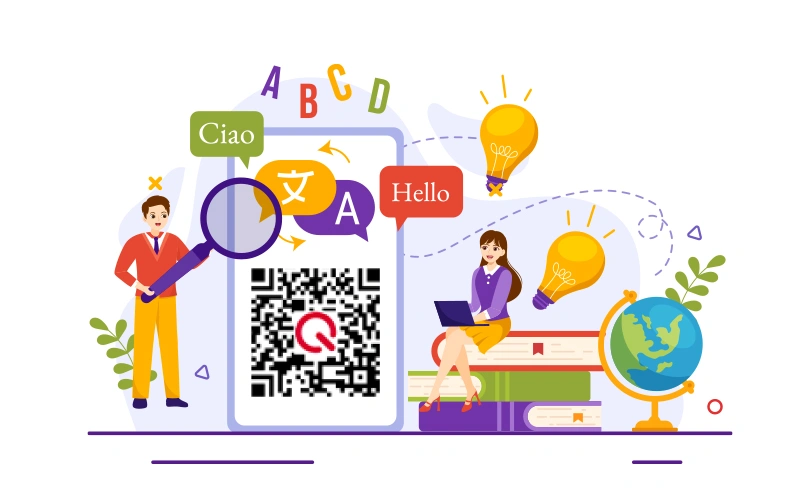
QR Codes for Language Learning and Translation
In today’s interconnected world, learning new languages and navigating unfamiliar ones can feel like unlocking a superpower. However, challenges such as interpreting signs, instructions, or menus in different languages can make communication difficult. QR codes are stepping in as game-changers to bridge this gap.
By scanning a QR code, users can quickly access translations, language-learning tools, or multilingual content tailored to their needs. These small but mighty codes have the potential to revolutionize how we learn and interact with languages.
Key Takeaways
- QR codes simplify language translation by providing instant access to multilingual content.
- Multilingual QR codes adjust to the user’s preferred language based on their device settings, making global communication seamless.
- Businesses can leverage QR codes for international customer support, product instructions, and enhanced user experiences.
- Dynamic QR codes enable real-time updates, data tracking, and flexible content management for translations.
- Custom QR code solutions incorporate branding, enhancing engagement while ensuring multilingual communication.
Understanding Multilingual QR Codes
What is a Multilingual QR Code?
A multilingual QR code allows users to scan and access information in their preferred language. It works by detecting the device’s language settings and directing the user to content tailored for that language. For instance, scanning a QR code on a product package can lead to usage instructions in French, English, or Spanish, depending on the user’s default device language.
How Does It Work?
- Multiple URLs: A single QR code is embedded with multiple URLs, each linked to a specific language version of the content.
- Language Detection: When scanned, the QR code reads the user’s smartphone or device settings to determine their language preference.
- Redirect: The code redirects the user to the corresponding page in their preferred language.
This functionality ensures accessibility and relevance, breaking language barriers and enhancing usability.
Benefits of Using Multilingual QR Codes
1. Expand Audience Reach
Businesses and educators can cater to international audiences by embedding QR codes in their content. These codes eliminate language barriers, opening the door to wider communication and engagement.
2. Improve Accessibility
By providing information in multiple languages, QR codes empower non-native speakers to understand content more easily. From product instructions to customer support, this innovation ensures inclusivity.
3. Enhance Customer Experience
Users appreciate personalized experiences. Multilingual QR codes make it seamless for customers to access relevant content, whether it’s troubleshooting instructions or localized promotions.
How Businesses Can Use Multilingual QR Codes
On Product Packaging
Embed QR codes on packaging to offer multilingual instructions, ingredient lists, or user guides. A single scan allows customers to view essential details in their native language, enhancing trust and usability.
On Websites and Apps
Integrate QR codes into app-first websites to direct users to translated content or customer service portals. This integration supports global users while maintaining a streamlined online experience.
For Customer Support
QR codes linked to multilingual help desks or FAQs can transform customer service. Businesses can address customer queries in their preferred language, boosting satisfaction and loyalty.
How to Create Multilingual QR Codes for Language Translation
- Select the QR Code Type
- Decide between static or dynamic QR codes based on your content needs. Dynamic codes allow for real-time updates and tracking.
- Add Languages and URLs
- Determine the languages to include.
- Create corresponding URLs for each language.
- Ensure translations are accurate and culturally relevant.
- Customize with Branding
- Incorporate logos, brand colors, and a clear call-to-action to make your QR codes visually engaging and recognizable.
- Test and Download
- Test QR codes on various devices to ensure functionality.
- Download in high resolution for use on packaging, signage, or digital materials.
Dynamic QR Codes: The Future of Language Translation
Edit and Update in Real-Time
Dynamic QR codes allow for seamless content updates without requiring a new QR code. This feature ensures translations and information remain current, ideal for evolving content.
Track Engagement Data
Track scan locations, user preferences, and engagement metrics to refine language strategies and assess global reach.
Make Signage Multilingual
Incorporate QR codes on signs for public spaces, airports, or events to provide multilingual information. Users can instantly access translations, improving accessibility and inclusivity.
Conclusion
QR codes are reshaping the way we learn languages and interact across linguistic boundaries. From enhancing accessibility to supporting businesses in global communication, the potential of this technology is immense. By integrating QR codes into educational and business strategies, organizations can foster inclusivity, expand their reach, and simplify communication for diverse audiences.